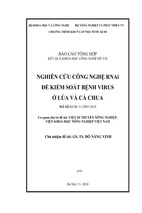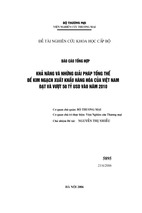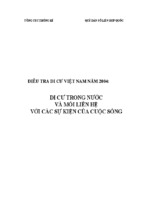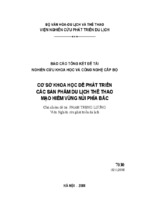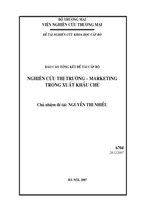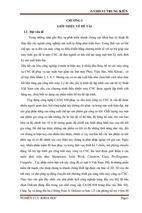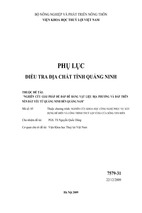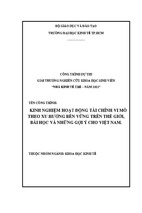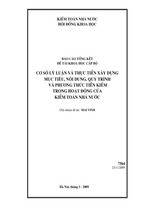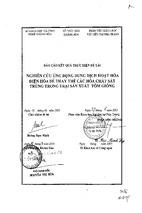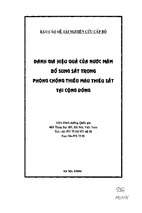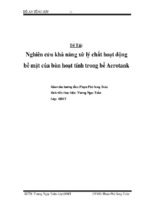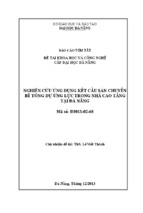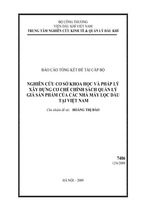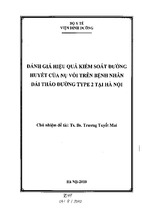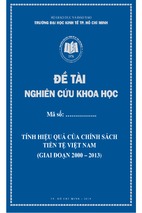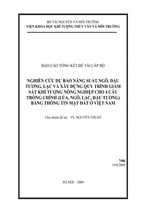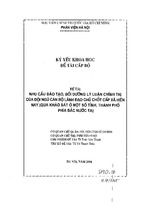MINISTRY OF EDUCATION AND TRAINING
UNIVERSITY OF ECONOMICS, HO CHI MINH CITY
----------------------
PHAN BICH TRAN
RURAL WOMEN AND GOOD JOBS
A CASE STUDY OF KRONGPA VILLAGE
MASTER OF PUBLIC POLICY THESIS
HO CHI MINH CITY, 2011
MINISTRY OF EDUCATION AND TRAINING
UNIVERSITY OF ECONOMICS, HO CHI MINH CITY
FULBRIGHT ECONOMICS TEACHING PROGRAM
----------------------
PHAN BICH TRAN
RURAL WOMEN AND GOOD JOBS
A CASE STUDY OF KRONGPA VILLAGE
Public Policy Major
Code: 603114
MASTER OF PUBLIC POLICY THESIS
SUPERVISOR
Dr. JONATHAN R. PINCUS
HO CHI MINH CITY, 2011
i
CERTIFICATION
I certify that the substance of the thesis has not already been submitted for any
degree and is not being currently submitted for any other degrees.
I certify that to the best of my knowledge any help received in preparing the thesis
and all sources used have been ackknowleged in the thesis.
The study does not necessarily reflect the views of the Ho Chi Minh Economics
University or Fulbright Economics Teaching Program.
Author
Phan Bich Tran
ii
ACKNOWLEDGEMENT
I would like to express my deep gratitude to my parents and my husband who
always encourages me in my life and my studying.
I would like to express my sincere appreciation to my supervisor, Dr. Jonathan R.
Pincus, who has helped me in performing the thesis. With rich knowledge, experience and
enthusiasm, he has effectively contributed to my thesis.
I would like to thank all my teachers in Fulbright Economics Teaching Program,
who have retransmitted a lot of their knowledge and experience to me.
I would like to thank all officials in KrongPa People’s Committee, who have
supported a lot of worthy information and knowledge about people and cultures in
KrongPa village during research process.
Last but not least, I express my thanks to all of my friends who share a lot of
knowledge and encourage me in performing the study.
Phan Bich Tran
Ho Chi Minh City – May, 2011
iii
ABSTRACT
The study focuses on testing existing theories about falls in poverty, escapes from
poverty escaping and employment in a group of women in KrongPa village. The thesis
finds that the three main factors affec falling into poverty are health care expenses, debt
and loss of land due to building the Ba Ha hydroelectric power. Income diversification and
farm size are the two main factors helping women escape from poverty. Meanwhile, the
reason why some women get better jobs than others is because they have high educational
attainment, they attended government agricultural programs, their parents have enough
resources to support their education and migration to big cities and they have larger farm
sizes. Therefore effective policy recommendations to increase the rate of women earning
stable incomes are focusing on increasing access to education as well as improving their
farm skills.
iv
TABLE OF CONTENTS
CHAPTER 1: INTRODUCTION……………………………………………………… 1
1.1. Problem Statement……………………………………………………………… 1
1.2. The scope and the purpose of the study………………………………………… 3
1.3. Research questions of the study………………………………………………… 3
1.4. The structure of the study……………………………………………………….. 3
CHAPTER 2: LITERATURE REVIEW……………………………………………... 5
2.1. Concepts…………………………………………………………………………. 5
2.2. Theoretical background…………………………………………………………. 5
2.2.1. Theory of Poverty and Poverty Reduction…………………………………6
2.2.2. Theory of Poverty in Ethnic Minorities…………………………………… 7
2.2.3. Theory among women…………………………………………………….. 7
2.2.4. Employment……………………………………………………………….. 8
CHAPTER 3: DATA AND METHODOLOGY……………………………………… 9
3.1. Methodology……………………………………………………………………. 9
3.2. Data……………………………………………………………………………… 10
CHAPTER 4: KRONGPA CASE STUDY AND RESULTS………………………… 12
4.1. KrongPa case study……………………………………………………………… 12
4.2. Results…………………………………………………………………………… 17
CHAPTER 5: CONCLUSION………………………………………………………… 33
5.1. Conclusion ……………………………………………………………………… 33
5.2. Policy recommendations……………………………………………………….... 34
5.3. Limitations of the study ………………………………………………………… 36
v
ABBREVIATIONS
MOLISA: Ministry of Labor – Invalids and Social Affairs.
VHLSS: Vietnam Households Living Standard Survey.
VBSP: Vietnam Bank for Social Policy
vi
TABLES
Table 4.1.1: Poverty rate compared with others, 2008-2011…………………………….. 12
Table 4.1.2: Number of households, poor households in Son Hoa in 3 years………….. 12
Table 4.1.3: Poverty over 3 years in KrongPa village…………………………………… 13
Table 4.1.4: Poverty rate in KrongPa village in 2011…………………………………… 13
Table 4.1.5: Micro Credit in KrongPa village…………………………………………….14
Table 4.2.1: Cost of daily meal per household in KrongPa village……………………….17
Table 4.2.2: How often each household has meat in their daily meal…………………….17
Table 4.2.3: Number of winter coats of each child………………………………………. 18
Table 4.2.4: Credit in KrongPa village…………………………………………………... 19
Table 4.2.5: Favorite payment methods of credit in KrongPa village…………………… 19
Table 4.2.6: Education levels of women’s children in KrongPa village……………….... 20
Table 4.2.7: The reasons why aged school children dropped out of school………………20
Table 4.2.8: Number of rooms of in KrongPa villagers’ house………………………….. 21
Table 4.2.9: Households goods in each KrongPa villager’s house………………………. 22
Table 4.2.10: Reasons of falling into poverty of KrongPa villagers………………………24
Table 4.2.11: Diversifications of income source of women who escaped poverty
in KrongPa village……………………………………………………………………...... 25
Table 4.2.12: Farm sizes of women who escaped poverty in KrongPa village………….. 25
Table 4.2.13: Incomes of women who escaped poverty in KrongPa village…………….. 25
Table 4.2.14: Women’s main jobs in KrongPa village…………………………………... 26
Table 4.2.15: Women’s second jobs in KrongPa village………………………………… 27
Table 4.2.16: Compare women’s main jobs and education……………………………… 27
Table 4.2.17: Comparison of farm yields among women who attended agricultural program
and those who did not……………………………………………………………………. 28
Table 4.2.18 – Compare women’s main jobs and skills…………………………………. 28
Table 4.2.19 – Comparison of women’s main jobs and farm sizes……………………… 30
vii
FIGURES
Figure 1.1.1: Income among kinds of employment……………………………………… 2
Figure 1.1.2: Labor between urban and rural areas……………………………………… 2
Figure 1.1.3: Female labor in rural areas………………………………………………… 2
Figure 4.2.1: Trends in household poverty in KrongPa…………………………………. 16
1
CHAPTER 1
INTRODUCTION
1.1.
Problem Statement
While researchers and policy makers are finding out solutions to help people
overcome their poverty, the poor themselves cannot wait for the benefits of economic
growth. They actively seek ways to survive without help from the government. They do
not even know that they are the subjects of the government’s concern. It is difficult to find
out the causes and trends of poverty from the poverty data. But the story behind these
causes and reasons are different in countries all over the world.
In order to understand the causes of poverty we must move beyond static analysis
of headcount rates to investigate poverty dynamics, in other words, the reason households
fall into poverty or climb out of poverty. According to Antolin et al (1999), job loss is one
of the reasons that people become poor. Good jobs bring a stable income which is enough
for daily living and expenses such as school and medical fees. Jobs are important to study
because they bring income which is the only criterion to determine the poverty line in
every part of the world.
The official poverty line in Vietnam has been changed from VND 200,000 to VND
400,000 per month in rural areas due to inflation in recent years (Decision No.
09/2011/QĐ-TTg date 31/01/2011). This change must make the poverty rate in rural areas
increase dramatically where income from farm employment is much lower than in nonfarm employment. In Vietnam, the bottom twenty percent of the population by
comsumption works in agriculture while the richest twenty percent is in non-farm
employment (Figure 1.1.1). It is obvious that most of the rural population participates is in
farm employment (Figure 1.1.2) including wage and self employment.
Despite the uncertainty of income, the importance of farm employment to the
economy is certain. The government tries so hard to create as much off-farm employment
as possible in rural areas to diversify income. Empirical studies show that about fifty
percent of rural women quickly join in off-farm jobs to diversify their income while their
husbands keep in farm work. That helps their family cope with changes in agriculture
product prices and the seasonality of agricultural employment and income (Figure 1.1.3).
2
Figure 1.1.3 – Female labor in rural area
Source: VHLSS 2008
Studying access to jobs and their role in the individual’s life will shed light on the
reasons why some households are not as poor as others and how some have escaped
poverty. Through detecting the real causes behind the participation of women in the labor
market, this study contributes a different dimension to the field of poverty research and
poverty reduction which may be a reference for other studies. The study results will give a
new story about how poverty is created and how it is overcome in practice. This topic is
one of the important parts of national development strategies in every country. It is not
only the responsibility of government but also a significant issue in the policy decisions of
government.
3
1.2.
The scope and the purpose of the study
The research is written as a case study so that all findings are just relevant to the
context of the study location. More generalizable findings must await large-scale, national
research on poverty dynamics. The contribution of this study is to investigate the dynamic
processes of poverty reduction in one location. The findings contribute to poverty
knowledge in an ethinic minority community. In order to understand poverty theories and
to place these theories in context, the study will consist of an in-depth case study of one
location in which poverty is a persistent problem. This study focuses on how women can
earn a stable income and help their families escape poverty. A lack of information in
quantitative studies and the absence of information on migrants are obstacles to
understanding poverty and poverty escapes in rural areas in Vietnam. The study will tell an
interesting story about a boundary village where many Rhade have lived for a long time.
This story will shed light on some factors affecting employment that might be not the same
as in other places.
For this purpose and context, the scope of this study will focus on a village which
supplies a case study to implement the purpose of the research.
1.3.
Research questions of the study
The study will attempt to answer three main research questions:
Question 1: Why do some women get better jobs than others?
Question 2: Why are some women more vulnerable to falling into poverty than
others?
Question 3: What is the importance of jobs to poverty escapes?
1.4.
The structure of the study
The study consists of five chapters. Following this introduction, the rest of the
study is structured as follows. Chapter 2 is devoted to the literature review in order to
provide the analytical framework for the thesis. It presents concepts, discusses the
theoretical background, and then lays out a framework for studying the reasons why some
women get better jobs than others. Chapter 2 reviews empirical studies concerning poverty
among women, poverty in ethnic minority communities and employment which is tested in
the thesis on a group of women. Chapter 3 decribes the data, sets out the study
4
methodology, and discusses the implementation of the survey. Chapter 4 presents the
results from KrongPa village, the location that is the subject of the case study. Chapter 5
concludes with a summary of main findings and policy recommendations. It also includes
some remarks on the limitations of the study.
5
CHAPTER 2
LITERATURE REVIEW
2.1.
Concepts
There are two different kinds of poverty in this study. The poverty in statistical
reports from government is defined as the national poverty definition. Another term of
poverty which is used to implement this study is defined in terms of these elements:
“ Villagers in this region, men as well as women, deem themselves (and others) poor when
their households do not have enough to eat or decent clothes to wear, when they accumulate more
debt without being able to repay installments due on past debts, and when they cannot afford to
send their children to school. They work hard to achieve at least this bare minimum for their
households.”
Krishna, Anirudh (2004), “Escaping Poverty and Becoming Poor: Who Gains,
Who Loses, and Why”, World Development, Vol. 32, No. 1, pp. 123
The official poverty line is VND 400,000 per month in the rural mountains and
island regions (Decision No. 09/2011/QĐ-TTg date 31/10/2011). The Ministry of Labor,
Invalids and Socail Affairs (MOLISA) surveys poor households at the village level and is
able to produce a detailed picture of where the poor live and what they need.
Good jobs are defined as jobs which provide women a stable income all the time to
help them have a decent life (Krishna, 2004).
“A livelihood comprises the capabilities, assets (stores, resources, claims and access) and
activities required for a means of living: a livelihood is sustainable which can cope with and
recover from stress and shocks, maintain or enhance its capabilities and assets, and provide
sustainable livelihood opportunities for the next generation; and which contributes net benefits to
other livelihoods at the local and global levels and in the short and long term”.
Chamber & Conway (1992) cited in Scoones, Ian (1998), “Sustainable Rural livelihood: A
Framework for Analysis”, IDS Working Paper No. 72, Institute of Development Studies.
2.2.
Theoretical background
Poverty tends to be higher in rural than urban areas because of the lack of access to
employment opportunities and lower average labor productivity in rural areas. There are
fewer ways to earn income, less education, health care and even more vulnerability to the
weather and forces of nature. So individuals choose to leave their villages because there
6
are more economic opportunities in urban areas where they can improve their living
earnings (Perkins 2006, pp.218-9). Although there is not enough evidence to show that
women are poorer than men, women are believed to have many disadvantages compared to
men. Those disadvantages are in property rights, in primary and secondary educations, in
wages and in sex-selection abortion (Perkins 2006, pp.219-20).
One of efficient way to reduce poverty rate in rural areas is livelihood diverfication
for farmers, particularly in creating more and more non-farm activities. There are six
factors that affect to income sources diversification: season, risk, labor market, credit
market, asset strategy, attitude toward risk (Tran 2009). The study is based on the theory of
sustainable livelihood to analyze how to help women get better jobs than others. According
to Scoones, identifying what livelihood resources are required for different livelihood
stragety conbinations is a key in the process of analysis. For example, successful
agricultural program may combine access to natural capital (e.g. land, water) with
economic capital (e.g. technology, credit) or social capital (e.g. social networks).
2.2.1. Theory of Poverty and Poverty Reduction
There is no common answer for all poverty problems in every part of the world.
Although “growth is good for the poor”, economic growth itself, however, is not enough
for the poverty reduction among the poorest groups of population (Dollar and Kraay 2002,
Foster and Szekely 2008). No one can be sure that growth will lead to poverty reduction
among the poorest because some people will benefit from growth but others do not. The
probability that some poor people will not earn any benefit is high because of many
obstacles that they face in increasing their incomes. On the other hand, the debate on
whether growth leads to poverty reduction or not is not a policy debate, since growth is not
a policy instrument (Kanbur et al 2009). Policies include increasing investment in
education, in agricultural productivity, and reducing obstacles to mobility to accelerate
poverty reduction (Pincus 2009). Observing 35 villages in India, Krishna concludes that in
more than 85 percent of all cases of declines into poverty, three principal factors are at
work. The first factor is health. Large expenditures on healthcare will deplete savings even
if the poor do not lose their jobs. Debt is the second reason. Households that need to make
large and unexpected expenditures, especially on healthcare, have to borrow at high
interest rates. Private lenders’ rates of interest vary with the economic conditions of the
7
borrower but they are mostly high. These debts quickly become a burden to households,
particularly poorer villagers. Funerals and marriage parties constitute the key item of social
expenditure in most villages because of traditional obligations. These three factors account
for more than 85 percent of all cases of decline into poverty. He also suggests that
diversification of income sources, reliable kinds of information, irrigation projects and
farm size are the factors contributing to poverty escapes. One of the ways to diversify
income in the farming households is to have higher allocations of land to perennial crops
(World Bank & Vietnam Development Report 2004).
2.2.2. Theory of Poverty in Ethnic Minorities
The vast majority of ethnic minority people in Vietnam are farmers whose living
conditions are more difficult than Kinh or Chinese households. The Vietnam Development
Report 2004 showed that ethnic minorities are less well-educated than Kinh or Chinese
people. Primary school enrolment rates for ethnic minority children are about 80 percent,
approximately 12 percentage points behind Kinh and Chinese counterparts. In secondary
school, ethnic minority children drop out of school more because of language and cultural
barriers, poor infrastructure and accessibility, poor quality of teachers, low suitability of
the curriculum, and the perception that returns to education are low (UNDP & Poverty
Task Force 2002, DFID & Poverty Task Force 2002, cited in World Bank & Vietnam
Development Report 2004, pp. 28). Moreover, 40 percent of ethnic minorities in the
Central Coast and Central Highlands give birth at home without any professional
assistance. This causes many health problems after birth.
Only 13 percent of ethnic minority people work in wage employment (World Bank
& Vietnam Development Report 2004, pp. 29). Most of them have forestry land and
employ themselves. The tradition of swidden of ethnic minority farmers makes the land
become less fertile which results in poor performance of farmers’ crops.
2.2.3. Poverty among women
The role of women in Kinh and ethnic minority households is different. Kinh
women play a limited role in community life in rural areas of Vietnam. Participation in
village meetings by women is described as being limited because women are busy working
either in the fields or in the house. If they do attend the meetings, respondents suggested
women would be among the quieter voices in the room (World Bank & Vietnam
8
Development Report 2004, pp. 25-29). Single-parent women who are divorced or deserted
by their husbands are likely to be poor in rural areas.
2.2.4. Employment
Job loss is one of the main reasons that people become poor (Antolin et al 1999).
The main income resource is from jobs so that if people lose their jobs, they do not have
any resources to meet their living expenses. Some people become poorer than others
because they might have worse jobs that do not help them to have a stable income for any
crisis circumstances.
Studies in factors that influence decisions of rural farm households to participate in
non-farm employment show that education, skills and distance (Sanchez 2005) or credit
and farm size (Beyene 2008) are signification factors. Although finding significant factors,
most these studies in this field have missed the fact that people in rural areas can take both
farm and off-farm jobs at the same time to support their families. Many poverty studies in
Vietnam and elsewhere omit migrants because national statistical sources generally miss
short-term and even long-term migrants (Pincus & Sender 2008). If we were able to
include migrants, we would find that temporary wage work is very important to household
survival and escape from poverty. Many studies also find that rural women participate
actively in off-farm employment (Sanchez 2005 and Beyene 2008).
9
CHAPTER 3
DATA AND METHODOLOGY
3.1.
Methodology
This thesis consists of a case study which is defined as a strategy to conduct
research which includes empirical study about a specific phenomenon using diverse forms
of evidence (Robson 2002, trích trong Saunders và đtg 2007). The reason why the case
study method was chosen is that it is the most appropriate method to explore and explain
unknown values (Saunders, Lewis & Thornhill 2007). Therefore, the explorations are only
directly relevant to the context in KrongPa village, Son Hoa district, Phu Yen province.
However, the story of KrongPa village will be valuable to assess existing theories, to
unveil the hidden causes which make it hard for women to access the stable income jobs.
The study is also support by in-deep interviews. There is a lot of information which
can not be revealed by data such as the history of poor villagers, how they fell into poverty,
what happened to make them fall in debt. The in-deep interviews were made after all the
questions in the prepared questionare were answered. The respondents were asked to tell
their story about their lives three years ago about their jobs, their house conditions, their
children’s education, their happiness. And then, they were asked to remember what
happened to change their lives, how they changed, how their lives were since then, what
they think to make their lives change like that. Most of women can not remember all things
happened in their lives, they just remember one thing which they think it is a reason for all.
They aslo need help from neighbours who sit there to listen and to join their stories. The
in-deep interviews were made with Buon’s women officers after as well after leaving from
respondents’ houses. The women officers will tell what they know about the respondents,
about their livestyles, their hard working, their difficulties which are not be told by
respondents. The in-deep interviews were made with Chiefs of Buon. The Chiefs of Buon
would help to explain some cultures of Rhade people for example why they took a lot
chilli in their daily food, why they eat yelllow ants and cassava leaves, what differences
between poor and non-poor Rhade households, what obstacles between Kinh and Rhade.
The interview was also made with specialist from Ba Ha hydroelectric power to understand
its process in compensation and create jobs for people who lost farm lands and house
because of its building.
10
The observation methods were also used to support findings of this study. The
interviewer started to observe the house conditions of respondents, materials of their house
roofs, walls, floors, children clothes and household goods to define how poor they are.
Observation methods also helpful to paint a colorful picture about Rhade livestyles and
cultures which can not be reached with desk research method. From that method, the
interviewer can feel deeply how is the poverty and how it affect to people lives which is
different from book review.
3.2.
Data
Because information relating to migrants is missing from all data sets to answering
the three research questions, an original survey was carried out in KrongPa village, Son
Hoa district, Phu Yen Province in final two weeks of January 2011.
Secondary data include information about the poverty rate, credit data from the
Vietnam Bank for Social Policies (VBSP) and agricultural development programs for poor
households. These data refer to the three years from 2008 to 2010 in three administrative
levels, namely the province, district and village.
The original data were all collected directly through structured interviews with a
prepared questionaire in KrongPa village. The questions are suitable not only to help
answer questions of “what” and “how” but also to give the explainations of “why”
households are poor. From the list of households in KrongPa People’s Committee, a 50
household sample was chosen randomly to interview from 736 households living in seven
Buon. Among the 50 chosen households, two households refused to answer and three
households could not be reached. One of them is the wife of the Chief of KrongPa People’s
Committee. Another woman is Rhade whose husband refused to allow her to be
interviewed. In three non-response households, women in two households died over 2
years ago, and in another household was absent because of a death anniversary in a
neighboring village.
Because there are no data sources which record information on migrants, the study
should also conduct research on the ten people who had left KrongPa village, living and
working elsewhere but still in Vietnam to ensure adequate information on the research
questions. These people are relatives of 50 chosen households selected randomly.
11
However, only seven are eligible to participate in the interview because the rest are men.
Among the seven women, there are three who are students at universities across the
country and one who did not agree to do the interview. Only three women agreed to be
interviewed by phone. For that reason, the real respondent rate of data collection is 94
percent1.
The interview process began by contacting the chief of the Buon, introducing the
research objectives and asking for guildance to the chosen households. The chief of the
Buon then scheduled times to meet the officers of the Women’s Union located in each
Buon who was the guide and translator in the interview process. Those officers were either
Kinh or Rhade depending on the majority of each Buon. For farming households, the
interview usually took place time from 16h to 20h because most farming women are in the
fields during the daytime. It was easier to interview households who have their own
enterprises.
The questions followed the list of topics and questions focusing on the relation
between poverty and jobs which was tested by pilot interview in Tan Binh Industrial Zone
in the middle of January 2001. The time of each interview was about 30 – 40 minutes.
After collecting, data were analyzed in statistical description to support explainations for
the study.
1
Real response rate = Number of respondents/(Number of people in sample – number of people who are not
elegible – number of people who can not be reached).
- Xem thêm -



